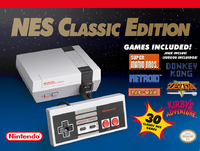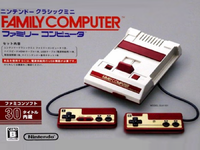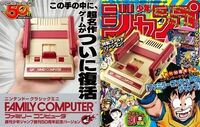NES Classic Edition: Difference between revisions
(really fix categories) |
(fix Ghosts 'n Goblins) |
||
| Line 127: | Line 127: | ||
| style="border-style: solid; border-width: 1px; text-align:center" | Yes | | style="border-style: solid; border-width: 1px; text-align:center" | Yes | ||
|- | |- | ||
| style="border-style: solid; border-width: 1px; text-align:center" | ''[[Ghosts 'n Goblins]]'' | | style="border-style: solid; border-width: 1px; text-align:center" | ''[[Ghosts 'n Goblins (video game)|Ghosts 'n Goblins]]'' | ||
| style="border-style: solid; border-width: 1px; text-align:center" | [[Capcom]] | | style="border-style: solid; border-width: 1px; text-align:center" | [[Capcom]] | ||
| style="border-style: solid; border-width: 1px; text-align:center" | Yes | | style="border-style: solid; border-width: 1px; text-align:center" | Yes | ||
Revision as of 06:38, 19 November 2023
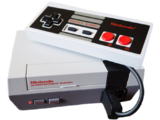 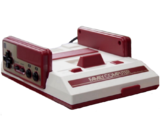
| |
| NES Classic Edition | |
| Designer | NERD |
|---|---|
| Manufacturer | Nintendo |
| CPU | 2 GHz Quad-Core ARM Cortex A7 |
| Graphics | Mali-400 MP2 |
| Memory | 256 MB |
| Media | 512 MB NAND flash |
| Released | JP: November 10, 2016 AU: November 10, 2016 NA: November 11, 2016 EU: November 11, 2016 Shonen Jump JP: July 7, 2018 |
| Added to Museum | NA: June 22, 2017 JP: August 10, 2017 Shonen Jump JP: June 10, 2019 |
NES Classic Edition, titled Nintendo Classic Mini: Nintendo Entertainment System in Europe and Oceania and Nintendo Classic Mini: Family Computer in Japan, was a miniature video game system by Nintendo. It was sold for a limited time beginning in November 2016. Despite strong interest and the inability to keep up with demand, Nintendo initially discontinued the system on April 13, 2017. In August 2017, after a strong demand for the system's follow-up, the Super Nintendo Entertainment System Classic Edition, Nintendo announced they would produce more NES Classic Edition systems in 2018. However, both the NES and SNES Classic Edition consoles were announced to be discontinued on December 14, 2018, and ceased production in 2019.
On July 7, 2018, Nintendo released a special edition in Japan to commemorate the 50th anniversary of the Weekly Shonen Jump comic, titled the Nintendo Classic Mini: Family Computer - Weekly Shonen Jump 50th Anniversary Version. This version contained 20 games that tied into Weekly Shonen Jump and the mini-console was colored gold.
The original systems contained thirty built-in games, while the Weekly Shonen Jump version contained 20 games. It was designed to resemble the Nintendo Entertainment System in North America, Europe, and Oceania, and the Family Computer in Japan. The Weekly Shonen Jump version was identical to the standard Japanese version except it was colored gold.
Each system contained a proprietary menu and an emulator by Nintendo European Research & Development to run the games.
Differences between regions
The only differences between the system released in North America compared to the system released in Europe and Oceania were the name and packaging. The system itself, the controller, the games, and the system software are identical. Both versions came with the same 30 built-in games that ran on an emulator developed by NERD. Both versions contained one controller, which was modeled after the original rectangular gamepad, which had a three-foot cord that connected to the system via a Wii Classic controller port. Both versions also had a second port that could be used for another controller. The power was provided by a standard mini USB plug and wall adapter, and the video was output through HDMI.
The standard Japanese release, on the other hand, was quite different. While it used the same emulator and had 30 built-in games, some were different from the Western release. This version was modeled after the Family Computer and had miniature built-in gamepads modeled after the original Famicom controllers. Unlike its Western counterpart, the Japanese release did not have Wii Classic Controller ports built-in and relied on the included miniature controllers, which were hard-wired to the system.
The Nintendo Classic Mini: Family Computer - Weekly Shonen Jump 50th Anniversary Version was colored gold and contained an entirely different set of games from the standard Japanese edition.
It had 20 built-in games that tied into the comics that appeared in Shonen Jump. These games ran on the same emulator as the standard releases, however, some of the graphics and music in the emulator's user interface are exclusive to this limited edition console.
Both Japanese releases contained controllers hardwired to the system, however, it is possible to add Wii Classic Controller ports to the Famicom Mini without damaging the unit.
Technical specifications
The system itself is much more powerful than the system on which it is designed.
It uses an Allwinner R16 "system on a chip". The system specifications are as follows:
- 1.2 Ghz quad-core Cortex-A7 CPU (central processing unit)
- 500 Mhz dual-core Mali-400 ARM GPU (graphics processing unit)
- 256MB RAM (random access memory)
- 512MB Flash storage
Since it uses common architecture, all regional variations of the system can be modified to add additional games, simply using the supplied mini-USB cable and open-source software.
Games comparison
The following table lists the games included in the NES Classic Edition and the Famicom Mini.
Games included in Nintendo Classic Mini: Weekly Shonen Jump 50th Anniversary Version
| Title | Developer |
|---|---|
| Captain Tsubasa (Released as Tecmo Cup Soccer Game in North America and Tecmo Cup Football Game in Europe.) |
Tecmo |
| Captain Tsubasa Vol. II: Super Striker (キャプテン翼II スーパーストライカー, Captain Tsubasa II: Sūpā Sutoraikā) |
Tecmo |
| Dark Myth: The Legend of Takeru Yamato (暗黒 神話: ヤマトタケル 伝説, Ankoku Shinwa: Yamato Takeru Densetsu) | Zap |
| The Devouring of Heaven and Earth (天地を喰らう, Tenchi wo Kurau) (Released as Destiny of an Emperor in North America.) |
Capcom |
| Dragon Ball: Shenlong's Riddle (ドラゴンボール神龍の謎, Dragon Ball: Shenron no Nazo) (Released in North America as Dragon Power and in France as Dragon Ball: Le Secret du Dragon.) |
Tose |
| Dragon Ball 3: Goku's Story (ドラゴンボール3 悟空伝, Dragon Ball Surī Gokūden) | Tose |
| Dragon Ball Z: Assault of the Saiyans (ドラゴンボールZ 強襲! サイヤ人, Dragon Ball Z: Kyoushuu! Saiya Jin) | Tose |
| Dragon Quest (ドラゴンクエスト, Dragon Quest) (Released in North America as Dragon Warrior) |
Chunsoft |
| Famicom Jump: Heroes History (ファミコンジャンプ 英雄列伝, Famicom Jump Hīrō Retsuden) | Tose |
| Famicom Jump II: The Strongest Seven (ファミコンジャンプII 最強の7人, Famicom Jump Tsū Saikyō no Shichinin) | Chunsoft |
| Fist of the North Star (北斗の拳, Hokuto no Ken) | Shouei System |
| Fist of the North Star 3: The Creator of the New Century - The Fantastic Legend (北斗の拳3, Hokuto no Ken 3: Shin Seiki Sōzō: Seiken Retsuden) | Shouei System |
| Kinnikuman: Muscle Tag Match (キン肉マン マッスルタッグマッチ, Kinnikuman: Massuru Taggu Matchi) (Released in North America as Tag Team Match: MUSCLE) |
Tose |
| Kinnikuman: Scramble for the Throne (キン肉マン キン肉星王位争奪戦, Kinnikuman: Kinniku-sei Ōi Sōdatsusen) | Tose |
| Magical Taruruto: Fantastic World!! (まじかる☆タルるートくんFANTASTIC WORLD!!, Magical Taruruto-kun: Fantastic World!!) | Sunsoft |
| Red Dragon King (赤龍王, Sekiryūō) | Sunsoft |
| Rokudenashi Blues (ろくでなしBLUES, Good For Nothing Blues) | Tose |
| Saint Saya: Golden Legend (聖闘士星矢 黄金伝説, Saint Seiya: Ougon Densetsu) (Released in France as Les Chevaliers du Zodiaque: La Legende d'Or, The Knights of the Zodiac: The Golden Legend) |
Bandai |
| Saint Saya: Golden Legend - Final Chapter (聖闘士星矢 黄金伝説 完結編, Saint Seiya: Ougon Densetsu Kanketsu Hen) | Bandai |
| Sakigake!! Men's Private School: Game No. 1 (魁男!塾・疾風一号生, Sakigake! Otokojuku Shippū Ichi Gō Sei) | Tose |
